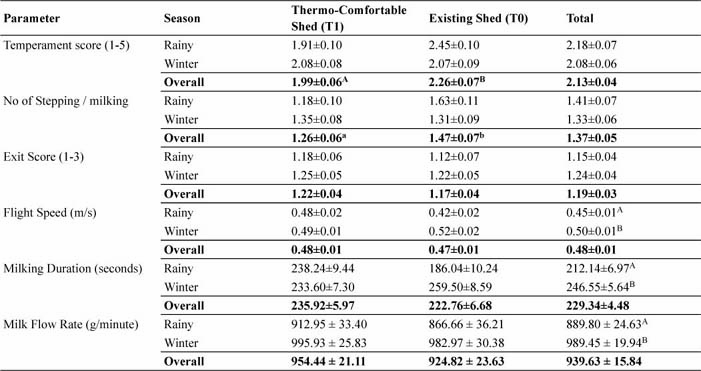
Journal of Animal Research: v.10 n.2, p. 315-323. April 2020
DOI: 10.30954/2277-940X.02.2020.22
Effects of Loose Housing Designs on Expressions of Milking Parlour Behaviour and Milk Yield of Crossbred Jersey Cows
ABSTRACT
Milking behaviour of dairy cows has serious impacts on their production efficiency. A number of genetic and environmental factors controls and influences milking behaviour of dairy cow. The aim of present study was to investigate the influence of housing comfort on expressivity of milking behaviours of cows in parlour, milk yield and compositions. Forty Jersey crossbred cows of similar production levels were selected and divided into 2 groups based on age, production and parity. Subsequently, cows were kept in two different types of loose house; each containing 20 animals. Two types of housing patterns were compared - (i) Traditional shed (T0) and (ii) Thermo-comfortable shed (T1). Impact of housing comfort significantly transformed the expressions of dairy cows behaviour even in milking parlour. Milking temperament scores and stepping during milking were significantly lower in cows kept in T1 compared to that of T0. Cows of thermo-comfortable shed showed more docile, calm and less nervous behaviour than those kept in traditional shed. Housing patterns significantly influenced daily milk yield (kg) being 2.86% more in T1 as compared to T0. Similarly milk compositions were better and significantly higher in T1 group of cows than that of T0. It was concluded that staying comfort of living by resignificantly modulated the expression of dairy cows behaviours even in milking parlour, demonstrated favourable milking temperament, reduced nervousness, enhanced milk yield and showed better milk compositions in Jersey crossbred cows.
Keywords: Animal housing, crossbred Jersey cow, Milking behaviour, Thermo-comfortable shed
Housing comfort is good indicator to improved welfare of animals and highly essential for optimization of livestock production performance. Stress conditions like uncomfortable lying area and heat load causes injury to hoof, body, leg, lying uneasiness etc. are some of the important deterrents to productivity under intensive management system. How animal behaves to its environment is an indicator of welfare and livestock housing is an integral determinant to animal welfare. Thus, improved welfare is directly related to expression of animals’ behaviour and production. Animal shows aberrant behaviour, if welfare is compromised. Resting is preferred over other behaviors by dairy cows (Munksgaard et al., 2005), and the duration of time cows spent lying is an indicator of good cow comfort and welfare through housing (Herlin, 1997).
Housing of lactating dairy animals reported to have some influences on milk production and behaviour in the milk parlour (Bencsik et al., 2006b; Fregonesi et al., 2007; Broucek et al., 2013). The evaluation of animal response to external stimuli and their degree of adaptation to the environment is gaining scientific interest now-a-days. In fact, it is a mean to develop housing systems that allow the animals to reach a satisfactory welfare and productive state.
How to cite this article: Kumar, A., Mandal, D.K., Mandal, A. and Bhakat, C. (2020). Effects of loose housing designs on expressions of milking parlour behaviours and milk yield of crossbred jersey cows. J. Anim. Res.,10(2): 315-323.
Usually dairy cattle are kept under conditions that are far from natural. One of the factors affecting milk production is the behaviour of dairy cows, otherwise known as the temperament, which is defined as an animal’s behavioural responses to handling by humans (Burrow, 1997; Sutherland et al., 2012). Environmental factors such as temperature, relative humidity, solar radiation, and air movement and their interactions often limit the performance of dairy cows (West, 2003) and livestock housing plays an important role in buffering the effects of external environment on animals’ body.
Dairy cattle provided with better micro-environment like thermo-comfortable shed were found to be less stressful during harsh environmental conditions and as a result their production performances and behaviour in staying byre were better as compared to animals not provided ameliorative ambience under tropical Indian conditions (Upadhaya et al., 2009; Mandal et al., 2016; Sahu et al., 2018; Sahu et al., 2019; Mandal et al., 2019). However, information on milk parlour behaviour of crossbred cows reared in different housing patterns under tropical conditions are limited. Whether comfort of living environment having any carry forward effects on dairy temperament and parlour behaviours or not had not been properly investigated. Currently, there is an increasing interest in improving animal temperament at the farm level due to the elevated awareness of its relationship with productivity and animal health (West, 2003). Keeping in view the above background, present study was intended to investigate the influence of housing interventions on alteration of behavioural response of cows in milking parlour, milk yield and its compositions in Jersey crossbred cows.
MATERIALS AND METHODS
Location of the study
The present study was carried out at ICAR-National Dairy Research Institute, Eastern Regional Station, Kalyani, West Bengal. The altitude of the city is 9.75 meter above mean sea level, latitude and longitude position being 22°58′30″N and 88°26′04″E, respectively. The weather of Kalyani is hot and humid; the maximum ambient temperature in summer goes up to 39oC and minimum temperature in winter comes down to about 8oC. The average annual rainfall is 1000-2000 mm, most of which is received from early June to September.
Experimental animals
The experimental animals were comprised of 40 Jersey crossbred cows distributed over 1st to 3rd lactations. Experimental observations were taken for 9 months (from September to May). Cows were divided into two groups (20 in each). Group-wise average age, parity, lactation stage, milk yield were similar in both the categories. One group (T1: Treatment group) was kept in Thermo-comfortable shed (Fig. 1 & 2) having thatched roof with ridge ventilation, more central height and 50% of the open paddock is of soil floor and rest 50% made up of plain cement concrete (PCC). The control group (T0) cows were kept in existing traditional shed (Fig. 3 & 4) having asbestos sheet as a roof material, less central height and entire floor (100%)of open paddock made up of PCC. The floor of covered area of both T0 and T1 shed was made up of PCC.
Feeding management of cows
All the feeding management practices and the feed ingredients were same for the both groups of lactating herd. Concentrate mixture, seasonal green fodder (ad libitum) and straw were made available to complete the nutrient requirements of all the lactating animals. The amount of concentrate requirement was calculated for every animal according to their body weight and milk production. Concentrate feed offered@1.5 kg/day as the maintenance (basal) diet between 8 to 8.30 A.M. and rest of the remaining amount was provided during milking. Clean and wholesome water was supplied throughout the whole day.
Recording of parameters
Milking was done by semi-automatic machine milking (DeLaval India), twice a day during morning from 6.00 to 8.00 AM and evening from 2.30 to 4.30 PM. The milk was weighed in kg and recorded for individual cow. Before milking, the animals were cleaned and groomed. Udders of cows were thoroughly washed with clean water before the milking. Towels soaked with antiseptic solution were used for wiping of teats and udder just before attaching the teat-cups.
The milk parlour behaviours of cows were recorded during milking operations 1m distance from behind without disturbing them. All the behavioural parameters were observed at weekly intervals by a single observer throughout the study period to avoid personal error variation. All the 40 animals were covered in one week duration during both morning and evening time milking by that single observer i.e., in one day including both time milking all the parameters considered were observed in 5-6 animals on an average on daily basis as all the parameters considered in the study were observed in weekly interval and repeatedly done for 9 months duration.
Temperament score (TS)
Temperament of each animal was observed at the milking parlour during the whole process of preparation for milking and actual milking with semi-automated milking machine. Temperament score was evaluated under 1-5 scale as per procedure of Gergovska et al. (2012) and Prasad and Jayalaxmi (2014).
Milk yield and its composition
Milk yield (kg) was recorded by a digital weighing balance on routine basis and milk composition (fat, protein, solids not fat) was evaluated by using milkoscreen equipment (indiFoss, Indifoss Analytical Pvt Ltd).
Parlour leaving speed or Flight speed (m/s)
It is the time taken by cows to cross a specified distance in milk parlour after their release from milking. Central passage was marked at 0.5 m intervals. The time interval to cover the measured specific distance was recorded by using stop watch. The parlour leaving speed was calculated as the total distance covered divided by time taken and denoted as meter per second (m/s).
Exit score
Exit score indicated patterns of movement of cows after releasing from parlour i.e. how animals are coming out of milk parlour at end of milking operations. It was done on a scale of 1 to 3 as described by Lanier and Grandin (2002).
Statement of animal rights (Ethical approval)
The use of cattle in this experiment was approved by the local institutional animal ethical committee vide institute approved project-NDRI/IRC Project code B-40 and it is an observational study.
Statistical Analysis
The data were analyzed using SPSS software (2007, 16.0 versions). The statistical methods used to analyze the data were General Linear Model and Chi-Square test. The level of significance was considered at 5% (P<0.05).
RESULTS AND DISCUSSION
Impact of housing on expressions of milk parlour behaviours of cows
The overall least squares mean ± SE of temperament score, exit score, parlour leaving speed, milking durations, and milk flow rate (MFR) of Jersey crossbred cows were 2.13±0.04, 1.19±0.03,0.48±0.01 m/s, 229.34±4.48 seconds and 939.63±15.84 g/min, respectively. The mean values of milking behavioural features and milk ability of Jersey crossbred cows of T1 and T0 groups’ were given in Table 1.
Jersey crossbred cows kept in Thermo-comfortable sheds (T1) showed more docile behaviour and exhibited less temperament score as compared to those kept in existing shed and the differences were significant (P<0.01). Milk flow rate, milking durations and exit score were higher in cows of T1 shed as compared to animals of T0 shed, however, differences were non-significant. Stepping behaviour shown by cows of existing shed was significantly (P<0.05) higher as compared to Thermo-comfortable shed. Stepping during milking is one of the most important components of milking behaviours shown in the parlour,because it helps in identifying the anxious cows. It gives an idea about nervousness in animals while milking operations is being carried out. More the numbers of stepping while milking more agitated is the cow. Thus, cows of T0 group exhibited more nervous behaviour in the parlour than T1 group.
Table 1: Least squares mean (± SE) of milking behaviours of Jersey crossbred cows kept at control and experimental sheds in different seasons (n=317)

Row-wise means different superscripts differ significantly for groups; Column-wise means different superscripts differ significantly for season (Uppercase Significant P<0.01; Lowercase Significant P<0.05).
Impact of housing comfort on milk yield
The overall least squares mean ± SE of milk yield of Jersey crossbred experimental cows was 6.74 ± 0.03 kg /day. The variations in milk yields of Jersey crossbred cows between groups and seasons were presented in Table 2.
Findings of present study revealed thathousing comfort significantly influenced the daily milk yield of cow. Cows maintained at Thermo-comfortable shed (T1) produced 190 g more milk /day, which was 2.86% higher than that of cows maintained in traditional shed (T0). Findings suggested that allocation of proper micro-environmental (temperature, humidity, ventilation etc.) conditions through comfortable housing designs enhanced milk yield (Table 2) and also modulated milking behaviours in Jersey crossbred cows (Table 1).
Impact of housing on milk compositions
The overall least squares mean ± SE of morning milk compositions such as fat, solids not fat (SNF) and protein per cent was 4.74±0.04, 9.12±0.01 and 3.95±0.02, respectively. The season and group-wise mean values of morning milk composition were given in Table 3. Present study revealed that fat, SNF and protein percent in milk of cows in experimental shed (T1) were higher compared to that of cows in control shed (T0) and values differed significantly. The overall least squares mean ± SE of evening milk compositions such as fat, SNF and protein per cent was 5.48±0.04, 9.14±0.02 and 3.96±0.02, respectively.
Seasonal variations of evening milk composition of Jersey crossbred cows between 2 housing patterns were given in Table 4. In the evening session of milking, fat % were found almost similar and did not differ significantly between two housing systems. Fat, SNF and protein % were found higher during evening session of milking as compared to morning session. Daily milk yield during evening was less as compared to morning. In general, milk compositions showed inverse relationship with milk yield.
Table 2: Least squares mean (± SE) of milk yields (Kg) /day/cow of Jersey crossbred cows (N=40) kept at Existing and Thermo-Comfortable sheds in different seasons (n=5700)

Row-wise means different superscripts differ significantly for groups; Column-wise means different superscripts differ significantly for season (A, B Significant P<0.01).
Table 3: Least squares mean (± SE) of morning milk compositions of cows kept at control and experimental sheds in different seasons (n=714)

Row-wise means different superscripts differ significantly for groups; Column-wise means different superscripts differ significantly for season (A, B Significant P<0.01; a, b significant P<0.05).
Impacts of housing on expressions of eliminative behaviours and vocalization in milking parlour
Incidences of different types of eliminative behaviours during milking operations give an idea about nervousness of animal while milking. Table 5 revealed that incidence of defecation, urination and bellowing (vocalization) in milking parlour was less in animals kept in T1 shed compared to that of T0, although the differences were non-significant (P>0.05). It indicated that if cows are provided favourable housing environment, they tend to become less nervous during milking operations and might perform better. Moreover, less nervous temperament helps in proper handling and restraining of cows during milking operations. Less defecation and urination facilitate clean milk production and maintaining hygiene of milking parlour.
Milking behaviour of dairy cows had been studied in relation to age, stage of lactation, daily milk yield, temperament of cattle during milking, parity etc. (Dickson et al., 1970, Kumar et al., 2019). Milking behaviour is mainly governed by temperament of cows and measured by expression of temperament score. Other behavioural features are entry order in milking parlour, side preference of milk parlour, exit score, fight speed/score, kicking during milking operation, stepping during milking operation, defecation, urination, vocalization etc. Milking behaviour (temperament) of cows has serious effect on their production efficiency.
Table 4: Least squares mean (± SE) of evening milk compositions of cows kept at control and experimental sheds in different seasons (n=521)

Row-wise means different superscripts differ significantly for groups; Column-wise means different superscripts differ significantly for season (A, B Significant P<0.01; a, b significant P<0.05).
Table 5: Incidence of eliminative behaviours and vocalizations of cows kept at Thermo-Comfortable and Traditional sheds

Housing of dairy cattle affects milk production and cows’ behaviour in the milking parlour. Overcrowded barns (Wierenga and Hopster, 1990; Leonard et al., 1996; Fregonesi et al., 2007) and long waiting time for getting access to milking parlour (Gomez and Cook, 2010) had been reported to affect the cows eating time availability and post milking lying behaviour. Like present study, pattern of housing of lactating dairy cattle have worse adverse effects on their behaviour and milk yield (Bencsik et al., 2006b; Fregonesi et al., 2007). Changes in housing pattern of lactating cow drops the milk yield for temporary period and huge decline in milk production was observed in older cows as compared to first lactation cows. The results obtained in the present study revealed that housing comfort of lying; feeding, resting and standing byre modulated the cows’ expressions of temperament in milking parlour. The cows of thermo-comfortable shed were more docile, calm and less nervous than those kept in traditional shed and obtained less staying comfort. Thus, the influence of shelter comfort was not only limited to the performance and behaviours in living byre, but also itsimpact was extendedup to their expressivity of behaviour in milking byre. Hence, present results indicated that behavioural rhythm of dairy cows could possibly be altered in favourable directions through shelter management interventions.
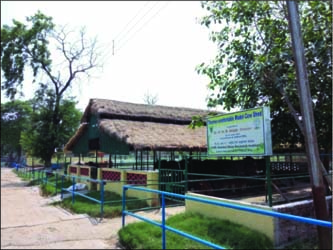
Fig. 1: Thermo-comfortable shed (T1)
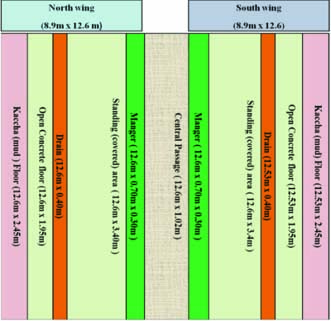
Fig. 2: Layout of Thermo-comfortable Shed (T1)
In tropical climatic conditions environmental factors are the most important determinants to declined milk yield of cows. Environmental factors such as temperature, relative humidity, solar radiation, and air movement and their interactions often limit the performance of dairy cows (Mandal et al., 2002; West, 2003; Upadhaya et al., 2009). Mandal et al. (2016) reported that under tropical environment Jersey crossbred cows showed a reduction of 170 g milk per cow per day during high stressful conditions.
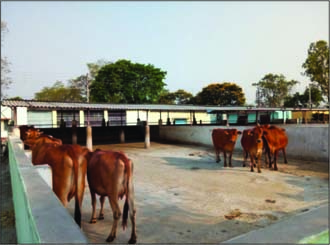
Fig. 3: Traditional shed (T0)
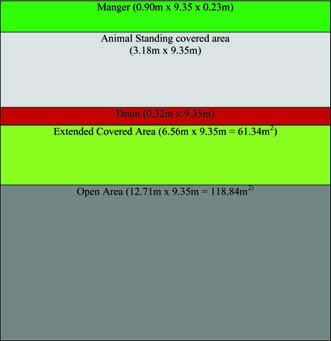
Fig. 4: Layout of Traditional Shed (T0)
Improvement in microenvironment of the shed through false roof reduced heat loads and helped maintaining normal physiological indices of cows and thereby showed more daily milk yield per cow (Mandal et al., 2018; Sahu et al., 2018; Sahu et al., 2019). Like present study, housing comfort provided in various forms improved the productivity of dairy cattle by protecting them from extreme climate (Bharambe et al., 2013; Kamal et al., 2014; Patil et al., 2014). In Holstein cows, heat stress reduced daily milk yield by 21% as the THI values went from 68 in the spring to 78 in the summer. Lower milk yields were recorded for confined Holstein cows in Mediterranean climate during spring as compared to summer (Bouraoui et al., 2002).
Lambertz et al. (2014) reported that fat percentage of bulk milk samples was negatively influenced by increasing THI values and the decrease was more pronounced in WG (warm loose housing with grazing) and WI (warm loose housing without grazing) compared with CG (cold loose housing with grazing) and CI (cold loose housing without grazing). In accordance, the protein percentage decreased with increasing THI (P < 0.001). Fat corrected milk was low in WG and WI compared with CG and CI (P < 0.05) in Holstein Friesian cows (Lambertz et al., 2014). Fat and SNF (%) were higher in animals of HF and Jersey breeds having shaded housing as compared to non-shaded housing (Collier et al. 1981). Heat stress significantly reduced milk fat content from 3.58% during the spring to 3.24% during the summer (Bouraoui et al., 2002). Milk protein percentage significantly (P<0.05) decreased as a result of summer heat stress (2.96 vs. 2.88%, respectively for the spring and summer).
In present study, milk compositions were decreased in the cows kept at traditional shed due to stress and uncomfortable micro environment in comparison to cows kept at thermo-comfortable shed. Because of favourable micro-environment in the specially designed experimental shed cows might have performed as per their potency; none the less, cows were able to arrest deterioration of milk quality / composition and quantity. Results indicated that if cows were provided comfortable environment through housing, they could perform to their potentials and also express more favorable milking behavioural features and created differences with less protected ones. Major implication of the present study was that milking temperament, tendency of nervousness and related milk parlour behaviours of dairy cows could be maneuvered in favourable directions through thermo-protective shelter management interventions.
CONCLUSION
Housing designs and staying comfort of living by resignificantly modulated the expression of dairy cows behaviours even in milking parlour, demonstrated favourable milking temperament, reduced nervousness, enhanced milk yield and showed better milk compositions in Jersey crossbred cows. Under tropical conditions, thatched roofed thermo-comfortable loose house dairy barns with open paddock having 50% soil floor and 50% concrete floor was better shelter for dairy cows compared to traditional concrete floored and asbestos roofed sheds.
ACKNOWLEDGMENTS
The authors are grateful to Director, ICAR-NDRI, Karnal and Head, ICAR-NDRI, ERS, Kalyani for providing necessary facilities.
REFERENCES
Bencsik, I., Pacala, N., Acatincai, S., Dronca, D., Stanculet, J. and Telea, A. 2006. Comparative study regarding the milking speed and the milk quantity attained from the Holstein Friesian cows using two types of pulsators. Lu-crari-Stiintifice-J., Seria Zootehnie, 49: 621–624.
Bharambe,V.Y., Patil, S.M. and Burte, R.G. 2013. Performance of lactating crossbred cows under different housing systems during summer in Konkan agro-ecological conditions. J. Anim. Res.,3(2): 197-201.
Bouraoui, R., Lahmar, M., Majdoub, A., Djemali, M. and Belyea, R. 2002. The relationship of temperature-humidity index with milk production of dairy cows in a Mediterranean climate. Anim. Res., 51: 479–491.
Broucek, J., Uhrincat, M., Tancin, V., Hanus, A., Tongel, P., Botto, L. and Bozik, I. 2013. Performance and behaviour at milking after relocation and housing change of dairy cows. Czech J. Anim. Sci., 58: 389–395.
Burrow, H.M. 1997. Measurements of temperament and their relationships with performance traits of beef cattle. Anim. Breed Abst., 65: 477–495.
Collier, R.J., Eley, R.M., Sharma, A.K., Pereira, R.M. and Buffington, D.E. 1981. Shade management in subtropical environment for milk yield and composition in Holstein and Jersey cows. J. Dairy Sci., 64: 844-849.
Dickson, D.P., Barr, G.R., Johnson, L.P. and Wieckert, D.A. 1970. Social dominance and temperament of Holstein cows. J. Dairy Sci., 53: 904-907.
Fregonesi, J.A., Tucker, C.B. and Weary, D.M. 2007. Overstock¬ing reduces lying time in dairy cows. J. Dairy Sci., 90: 3349– 3354.
Gergovska, Z., Miteva, T., Angelova, T., Yordanova, D. and Mitev, J. 2012. Relation of milking temperament and milk yield in Holstein and Brown Swiss cows. Bulgarian J. Agri. Sci., 18(5): 771-777
Gomez, A. and Cook, N.B. 2010. Time budgets of lactating dairy cattle in commercial freestall herds. J. Dairy Sci., 93: 5772–5781.
Herlin, A.H. 1997. Comparison of lying area surfaces for dairy cows by preference, hygiene and lying down behaviour. Swedish J. Agri. Res., 27:189–196.
Kamal, R., Dutt, T., Patel, B.H.M., Dey, A., Chandran, P.C., Barari, S.K., Chakrabarti, A. and Bhusan, B. 2014. Effect of shade materials on microclimate of crossbred calves during summer. Vet. World, 7(10): 776-783.
Kumar, A., Mandal, D.K., Mandal, A., Bhakat, C., Chatterjee, A. and Rai, S. 2019. Effect of milking temperament on milk yield, udder health and milk composition in crossbred Jersey cows. Int. J. of Livest. Res.,9(1):187-194.
Lambertz, C., Sanker, C. and Gauly, M. 2014. Climatic effects on milk production traits and somatic cell score in lactating Holstein-Friesian cows in different housing systems. J. Dairy Sci., 97: 319–329.
Lanier, J.L. and Grandin, T. 2002. The relationship between Bos Taurus feedlot cattle temperament and cannon bone measurements. J. Anim. Sci.,53.
Leonard, F.C., Oconnell, J.M. and Ofarrell, K.J. 1996. Effect of overcrowding on claw health in first-calved Friesian heifers. Br. Vet. J., 152: 459–472.
Mandal, D.K., Mandal, A., Bhakat, C., Chatterjee, A. and Karunakaran, M. 2016. Effect of climatic stress on milk production in Crossbred Jersey cows herd. J. Agric. Eng. and Food Tech., 3(3): 230-232.
Mandal, D.K., Rao, S., Singh, K. and Singh, S.P. 2002. Effect of macroclimatic factor on milk production in Friesian x Sahiwal half bred. Indian J. Dairy Sci., 55: 166-170.
Mandal, D.K., Sahu, D., Mandal, A., Chatterjee, A., Bhakat, C., Rai, S., Karunakaran, M. and Dutta, T.K. 2018. Alteration of micro-environment of animal shed through roof insulation by paddy straw - its seasonal efficacy and physiological impacts on Jersey crossbred cows. Indian J. Dairy Sci., 71(5): 483-490.
Mandal, D.K., Bhakat, C., Chatterjee, A., Mandal, A., Rai, S., Santra, A., Das, S.K. and Dutta, T.K. 2019. Shelter management of dairy crossbred cattle in small household milk production system. J. Basic and Appl. Eng. Res., 6(7): 379-381.
Munksgaard, L., Jensen, M.B., Pedersen, L.J., Hansen, S.W. and Matthews, L. 2005. Quantifying behavioural priorities – effects of time constraints on behaviour of dairy cows, Bostaurus. Appl. Ani. Beh. Sci., 92:3–14.
Patil, S.M., Bharambe, V.Y. and Khirari, P.B. 2014. Effect of shelter management on lactating crossbred cows during summer under the agro-climatic condition of Konkan region of India. J. Ani. Res., 4(1): 9-17.
Prasad, R.M.V. and Jaya Laxmi, P. 2014. Studies on the temperament of Murrah buffaloes with various udder and teat shapes and its effect on milk yield. Buffalo Bulletin, 33(2): 170-176
Sahu, D., Mandal, D.K., Dar, A.H., Podder, M. and Gupta, A. 2019. Modifcation in housing system affects the behavior and welfare of dairy Jersey crossbred cows in different seasons. Bio. Rhythm Res., https://doi.org/10.1080/09291016.2019.1619130
Sahu, D., Mandal, D.K., Bhakat, C., Chatterjee, A., Mandal, A. and Mandal, M. 2018. Effects of Roof Ceiling and Flooring on Microclimate of Shed and Physiological Indices of Crossbred Jersey Cows. Int. J. of Livest. Res.,8(4): 272-280.
Sutherland, M.A., Rogers, A.R. and Verker, G.A. 2012. The effect of temperament and responsiveness towards humans on the behavior, physiology and milk production of multiparous dairy cows in a familiar and novel milking environment. Physiol. & Behav., 107: 329–337.
Upadhaya, R.C., Ashutosh, K.A., Gupta, S.K., Gupta, S.V., Singh, S.V. and Rani, N. 2009. Inventory of methane emission from livestock in India. In Global climate change and Indian agriculture. Case studies from the ICAR Network project. P.K. Aggarwal (Ed), ICAR, New Delhi: 117-122.
West, J.W. 2003. Effects of heat-stress on production in dairy cattle. J. Dairy Sci., 86: 2131–2144.
Wierenga, H.K. and Hopster, H. 1990. The significance of cubicles for the behaviour of dairy cows. Appl. Ani. Beh. Sci., 26: 309–337.